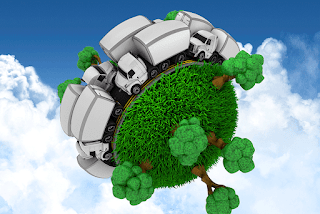Circular logistics: Reducing waste and enhancing sustainability
In today's world, where environmental consciousness is becoming increasingly
integral to business operations, the concept of circular logistics has emerged as a
beacon of hope for sustainability advocates. Circular logistics represents a paradigm
shift in how we approach supply chain management, emphasizing the reduction of
waste and the promotion of sustainability at every stage of the process.
At its core, circular logistics is about creating a closed-loop system where resources
are used efficiently, waste is minimized, and products are designed with longevity
and recyclability in mind. Unlike traditional linear supply chains, which follow a “take-
make-dispose” model, circular logistics seeks to create a circular flow of materials,
energy, and information, thereby reducing the overall environmental impact.
One of the key strategies employed in circular logistics is the adoption of reverse
logistics processes. Reverse logistics involves the movement of products and
materials from their final destination back to their origin for purposes such as
recycling, refurbishment, or disposal. By implementing effective reverse logistics
systems, companies can recover value from products that have reached the end of
their life cycle, thereby reducing waste and minimizing the need for new raw
materials.
Another important aspect of circular logistics is the concept of product-as-a-service
(PaaS) models. Rather than selling products outright, companies offer them as a
service, allowing customers to access the functionality of the product without the
burden of ownership. This approach encourages product durability and incentivizes
manufacturers to design products that are easy to repair, upgrade, and ultimately
recycle.
Circular logistics emphasizes the importance of collaboration and transparency
throughout the supply chain. By forging partnerships with suppliers, customers, and
other stakeholders, companies can exchange information and resources more
efficiently, leading to optimized processes and reduced waste. Transparency is also
crucial in ensuring that products are sourced ethically and manufactured in a way
that minimizes environmental impact.
In addition to operational strategies, technological innovations play a significant role
in enabling circular logistics. Advanced analytics, Internet of Things (IoT) devices,
and blockchain technology can provide real-time visibility into supply chain
operations, allowing companies to identify inefficiencies and implement targeted
interventions. For example, sensors can track the condition of products during
transportation, helping to prevent damage and minimize returns.
Furthermore, emerging technologies such as 3D printing and advanced recycling
techniques hold promise for closing the loop on material flows. 3D printing enables
on-demand manufacturing, reducing the need for large-scale production runs and
excess inventory. Meanwhile, advanced recycling technologies can break down
complex products into their constituent materials, allowing them to be reused in new
products without degradation in quality.
Despite the numerous benefits of circular logistics, its widespread adoption faces
several challenges. Resistance to change, lack of infrastructure, and regulatory
barriers are just a few of the obstacles that companies may encounter on the path to
circularity. However, with growing consumer demand for sustainable products and
increasing pressure to mitigate climate change, the momentum behind circular
logistics continues to build.






Comments
Post a Comment